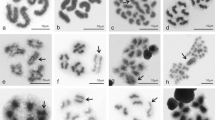Abstract
The chromosome complements of 45 species of spider mites (Tetranychidae) were studied, making the total number of species now examined in this family 57, approximately 10% of all species known. The chromosome numbers range fromn=2 ton=7. The modal number of the family is 3 (found in 44% of the species). It is argued that the ancestral number isn=2 (21% of the species).
In the more primitive subfamily of theBryobiinae both thelytokous and arrhenotokous species occur, whereas the subfamily of theTetranychinae exclusively exhibits arrhenotoky. The karyotype evolution is discussed in connection with arrhenotoky. It is stated that karyotype information is a useful tool for the spider mite taxonomist.
Similar content being viewed by others
References
Ballantyne G. H. (1969). Genetic fine structure and complementation at the albino-locus in spider mites (Tetranychus species:Acarina).Genetica 40: 289–323.
Gutierrez J. P. (1967). Contribution à l'étude morphologique deTetranychus neocaledonicus André 1933.Coton et Fibres Trop. 22: 183–195.
Gutierrez, J. P., W. Helle & H. R. Bolland (1970). Etude cytogénétique et réflexions phylogénétiques sur la famille desTetranychidae Donnadieu.Acarologica, in litt.
Helle W. (1965). Inbreeding depression in an arrhenotokous mite.Ent. Exp. & Appl. 8: 299–305.
Helle W. & H. R. Bolland (1967). Karyotypes and sex-determination in spider mites (Tetranychidae).Genetica 38: 43–53.
Muller H. J. (1925). Why polyploidy is rarer in animals than in plants.Amer. Nat. 59: 346–353.
Oliver J. H. & B. C. Nelson (1967). Mite chromosomes: an exceptionally small number.Nature 214: 809.
Pritcharb, A. E. & E. W. Baker (1955). A revision of the spider mite familyTetranychidae. Pac. Coast Ent. Soc. San Francisco, 472 pp.
Suomalainen E. (1959). On polyploidy in animals.Proc. Finn. Ac. Science 1958: 105–115.
White M. J. D. (1961). The chromosomes, Methuen & Co., London, 188 pp.
Author information
Authors and Affiliations
Additional information
This study was financially supported by the Netherlands Foundation for the Advancement of Tropical Research (W.O.T.R.O.) and the Uyttenboogaart-Eliasen Foundation.
Rights and permissions
About this article
Cite this article
Helle, W., Gutierrez, J. & Bolland, H.R. A study on sex-determination and karyotypic evolution inTetranychidae . Genetica 41, 21–32 (1970). https://doi.org/10.1007/BF00958891
Received:
Issue Date:
DOI: https://doi.org/10.1007/BF00958891




